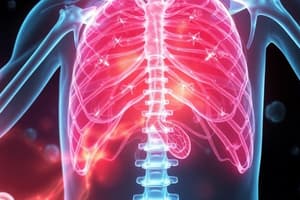Podcast
Questions and Answers
What clinical manifestation does the nurse expect to see in a client suspected of having hypercalcemia? (Select all that apply)
What clinical manifestation does the nurse expect to see in a client suspected of having hypercalcemia? (Select all that apply)
- Tachypnea
- Lethargy (correct)
- Decreased deep tendon reflexes (correct)
- Positive Chvostek
- Tachycardia
Which information from the assessment of a client with septic shock requires the most immediate action by the nurse?
Which information from the assessment of a client with septic shock requires the most immediate action by the nurse?
- Blood pressure reading
- Elevated temperature
- Urine description and output
- Lung assessment finding (correct)
Based on the results of the arterial blood gases (ABGs), what imbalance does the nurse understand the client to be exhibiting?
Based on the results of the arterial blood gases (ABGs), what imbalance does the nurse understand the client to be exhibiting?
- Respiratory acidosis compensated (correct)
- Metabolic acidosis partially compensated
- Metabolic acidosis compensated
- Respiratory acidosis partially compensated
What alterations in the arterial blood gases would the nurse expect to find in a client with agitation, diarrhea, and peripheral edema, taking a lot of antacids?
What alterations in the arterial blood gases would the nurse expect to find in a client with agitation, diarrhea, and peripheral edema, taking a lot of antacids?
Flashcards are hidden until you start studying
Study Notes
Hypercalcemia Clinical Manifestations
- Hypercalcemia results in elevated blood calcium levels, leading to lethargy and decreased deep tendon reflexes.
- Bradycardia is observed instead of tachycardia in hypercalcemia.
- Positive Chvostek's sign indicates hypocalcemia, not hypercalcemia.
Septic Shock Assessment Priorities
- Endotracheal tube misplacement can lead to inadequate left lung oxygenation, identified by absent lung sounds on the left side.
- Blood pressure of 92/54 mmHg indicates some organ perfusion but requires monitoring.
- Elevated temperature is secondary; prioritize airway management and lung assessment.
- Urine analysis reveals possible sepsis cause but should not take precedence over airway concerns.
Arterial Blood Gases (ABGs) Interpretation
- ABG results show pH of 7.35, indicating respiratory acidosis that is compensated; normal pH but acidic side noted.
- Elevated PaCO2 indicates acid formation; HCO3 is increased to buffer acid.
- Appropriate interpretation involves recognizing compensation mechanisms based on pH and PaCO2 relation.
Clinical Signs Related to Antacid Use
- Chronic antacid use can lead to metabolic alkalosis; expected ABG results may show elevated pH and HCO3 levels.
- Symptoms may include agitation, diarrhea, and peripheral edema due to alterations in electrolyte balance and acid-base status.
- pH of 7.50, PaCO2 of 35, and HCO3 of 32 are indicative of metabolic alkalosis.
Studying That Suits You
Use AI to generate personalized quizzes and flashcards to suit your learning preferences.




